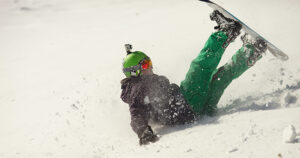Stay Safe From Winter Sports Injuries
It’s all fun and games, until some gets hurt. After watching the 2022 Winter Olympics, many of us have the desire to get out and enjoy some winter sports activities – like that two-man luge. That looked like fun!
Winter sports and activities are a great way to enjoy some fresh air and exercise. The benefits far outweigh the potential for injury. But every winter, around 200,000 Americans are treated for injuries related to winter sports. At OrthoIllinois, we see many injuries from winter sports activities including:
- Knee and ankle: When it comes to winter sports activities, our knees often absorb a lot of stress. They take the brunt of the impact, resulting in a higher incidence of injury. In the skiing population, we commonly see injuries to the ligaments and/or meniscus, including knee dislocations and fractures. Ankle injuries are common in the snowboarding population because of the twisting motion required to control the snowboard.
- Shoulder: It goes without saying that even the most advanced winter sports enthusiasts fall. A lot. Shoulder dislocations and injuries to the rotator cuff frequently result from an attempt to brace for a fall with outstretched arms.
- Hand and wrist: Wrist and finger sprains and fractures are common whether you’re on the slopes, the rink, or the cross-country trails. The thumbs are particularly vulnerable when skiing. Skier’s Thumb is a common injury due to one’s grip on the ski pole that can get caught in the snow placing a sidewise force on the thumb.
Preventing Winter Injuries
Participating in physical activity, especially outdoors, is invaluable to our overall health and mental wellbeing. Before you head out to enjoy your winter sport of choice, keep in mind the following:
- Warm up. Your muscles will be tight, especially in the cold weather, and taking a few minutes to stretch will go a long way in reducing the chance of injury.
- Learn how to fall. There’s a right way and a wrong way to fall and most of our patients are the ones who fell the wrong way. You can reduce your risk
 of injury by trying not to brace yourself and if possible, by falling on your side while attempting to roll through the fall. Falling often occurs when you’re overexerted, so know your limits.
of injury by trying not to brace yourself and if possible, by falling on your side while attempting to roll through the fall. Falling often occurs when you’re overexerted, so know your limits. - Drink lots of water. Dehydration can make you more prone to injury. Getting water to your muscles and joints will alleviate inflammation, cramps, joint friction, and fatigue.
- Take a lesson. It looks so easy on TV, but we all know how much training elite athletes go through. I’m not saying you must train to this level, but a few lessons will help develop your skills and improve your confidence, which in turn will help protect against injury.
- Don’t go alone. If you do sustain an injury, you don’t want to be alone. Find a skiing, snowboarding, or skating partner and enjoy your winter activities together.


